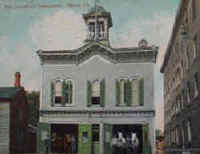| Sharon | |||||||
Sharon's Yesterdays & Tomorrow An Outline of the Growth of Sharon and its Industries.... and a History of the McDowell National Bank, June 1935
|
|||||||
|
|
An Outline of Sharon's History
Sharon’s first settlers came
during the second administration of President Washington and found a wild
virgin territory inhabited only by Indians. The first settlement was
established in 1795 when Benjamin Bentley
came from Washington County, Pennsylvania, and explored the region along
the Shenango River. He set up
a “tomahawk claim” of over 400 acres on the east side of the Shenango
River, and south of what is now State Street.
The next year he brought his wife and six children to Sharon in a
canoe, having erected a rude log cabin the year before.
There are now 5,700 homes in Sharon [1935]. The first white child born in
Sharon was James Bentley, who was born on May
23rd, 1798, just seventy years before the founding of the McDowell
National Bank. It is interesting to note, in
this connection, that the grandfather of Alexander
McDowell was the first white child born in Franklin, Pennsylvania,
his grandmother and grandfather having ridden on horseback from
Philadelphia to that point on their wedding trip. In 1798 William
Budd and Charles and Frances Reno came to Sharon. A great deal of
the downtown section of the city now covers what were the farms of these
early settlers. Other early settlers whose
names are still familiar ones in this district are:
Isaac Patterson, Samuel Quinby, Col. Henry
Hoagland, Daniel Bashara and John Hull, Captain John Elliott, Abraham
DeForest, Emanuel Hoover, Benjamin Haywood, Sr., George McCleery, Thomas
J. Porter, Henry Barnhart, Elias Jones and Dr. John Robert McCormick. The
latter was the first resident physician in Sharon. In 1814 Elias
Jones bought 100 acres of ground from Isaac
Patterson and, after clearing the lumber, farmed the land. He later
built the first distillery near the site of the present Sacred Heart
Church. He then erected a log building at the southeast corner of South
Main Avenue and West State Street in which structure he operated the first
dry goods store and grocery Store in Sharon. He also, in the same
building, kept the first hotel or inn, and the first postoffice. The first Justice of the Peace
was William Budd, Jr., who held the office
until 1825, when he was succeeded by Thomas J.
Porter, who had moved from Mercer to Sharon. He filled the position
for about thirty years. Sharon grew very slowly until
about the time of the founding of the McDowell National Bank in 1868. In
1840 it had 400 inhabitants; in 1850, 541, and in 1860, 900. Sonic impetus had been given
the town in the early 40s by the building of the canal which provided the
first cheap transportation. Probably on account of the stimulus of the
canal, the borough was incorporated on October 6, 1841. In the "Industrial
History" section of this booklet it will be found that the coal
industry began near Sharon in 1835 and laid the foundation for further
industrial development. |
Downtown Sharon about 1868
Sharon's Skyline about 1868
Sharon Fire Department 1909 More information on the Sharon Fire Dept.
Related information on:
|
|||||



